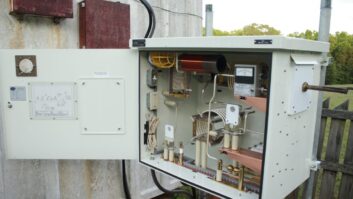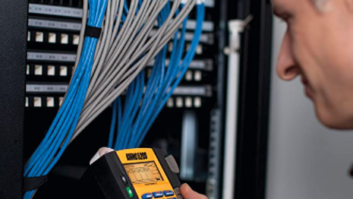Have you taken stock recently of supplies at your transmitter site?
How is the stock of air filters for air conditioners and transmitters? Do you have a supply of cleaning rags such as Rags-in-a-Box or shredded cotton T-shirt cloth?
Here’s one you might overlook: several gallon jugs of clean water. You can buy sealed water jugs, or recycle. The point is that you have good water for cleaning, drinking or an emergency.
When I was chiefing a station, I was doing a little spring cleaning. Unbeknownst to me, a container of muriatic acid was on the shelf where I was cleaning. I accidentally knocked it over.
When it hit the concrete floor, it spattered. A good portion spilled on my legs, eating through my jeans and burning me.
Fortunately, my assistant drove over to his home, fetching some bottled water so I could clean off. Scissors turned my jeans into shorts and we got the mess cleaned up.
A couple of gallon jugs of water were then kept at the site, just in case. The moral to that story (in addition to not storing such chemicals at the transmitter site) is to have an assistant with you – and make sure he lives near the transmitter site!
A number of years later, I found myself working on a transmitter. While I worked, it started snowing. A few hours later, I was snow-bound at the transmitter site. The two-gallon jugs of water stored at that site also came in handy.
If your station bought canned food for the Y2K disaster, transport some of it to the transmitter site. With multiple sites these days, you never know where you’ll be.
. . .
Lyle Henry, known as the Radio Doctor in Los Angeles, tells us of a neat place for all types of surplus connectors.
The Connector Distribution Corp. is a 50,000-square-foot warehouse packed with perhaps the largest connector inventories in the United States. Audio, circular, rectangular, industrial, military, PC board and coaxial plugs and connectors are stocked here.
These folks can cross-reference connector numbers and help you find the missing connector for your specific need. They even stock some Molex parts. The parts are all surplus, none are used. They’ll fill a $25 minimum credit card order and have a line card at www.cdc-online.com
If you have a hard-to-find connector need or are missing a connector for a piece of equipment, try these folks. Bob Averbach can be reached at (800) 421-5840
. . .
(click thumbnail)Fig. 1: A new ground system for a three-tower directionalI’m amazed at the number of AM stations that are “cleaning up their act” these days. So often in the rush to upgrade, we neglect to take pictures. Photos can be very helpful to engineers who follow in your footsteps years from now.
When upgrades occur, use a disposable camera to track the progress and keep the pictures at the transmitter site.
The pace was not so rushed back in 1981. Figure 1 shows a unique bird’s eye view of the “new” site for what was then WTGM in Salisbury, Md. The new ground system had just been installed, as evidenced by the plowed furrows for each radial.
(click thumbnail)Fig. 2: The way it was at one station in 1988
Chris Kelly, the market chief for the Salisbury Cumulus stations, shares this picture with Workbench readers. He also provided Figure 2 – talk about memories! This picture is an auxiliary production studio for WQHQ(FM) taken in March of 1988.
What’s fun is listing all the items we don’t use any more? With an eye to the future, is that a CD player sitting on top of the console? We’ve come a long way, baby! Thanks, Chris, for sharing how radio has matured.
The editor of Radio World also reminds me that he loves to get photos of your new facility, upgrade project or engineering staff at work for possible use in RW. Drop a note to Paul McLane at [email protected]


. . .
Bill Weisinger provides engineering services in the Cleveland area. EAS antennas have been a weak link in many EAS systems and are a particular pet peeve of Bill’s. All too often, the GM is too cheap to buy a second antenna to feed the EAS receivers. Some managers adopt the attidude, “What was thrown together 15 years ago should work fine now.”
Stations that have two area FM EAS stations as LP-1 and LP-2 assignments may have been tempted for various reasons to take the original EBS outside antenna feed and split it to feed both EAS FM tuners.
A potential problem is that in a severe storm, that single outside antenna could be damaged and take down both the primary and secondary EAS tuners with one good wind gust.
It may actually be more reliable to use an outdoor antenna on your LP-1 and (if the signal strength permits) use an indoor FM antenna for the LP-2. Perhaps consider using the indoor antenna for the strongest signal (signal to noise permitting) and let the outdoor antenna pull in the weaker signal.
Either way, the redundant tuner situation remains viable if the outdoor antenna system is damaged. If low signal strength is a problem for both monitored stations, consider installing two separate outside antennas on separate masts.
In the Cleveland areas, the LP-1 is an AM and the LP-2 is an FM.
An outdoor longwire antenna is used for the AM and an indoor antenna captures the more powerful FM signal. Should the AM antenna fail, the indoor antenna for the FM remains intact.
Some stations use the National Weather Service VHF signal as an optional EAS input. Rather than using a cheap omnidirectional “scanner” antenna, you may reap signal rewards from an inexpensive outdoor directional three-element VHF Yagi antenna, tuned to 162 MHz.
This antenna not only provides considerable gain when aimed at the nearest NWS transmitter, delivering a much cleaner signal to the tuner, but also has the advantage of nulling other NWS co-channel signals or pesky adjacent channels.
Cost is not an issue either, the Maxrad MYA 1503 costs less than $50 from Tessco.
I don’t know about where your stations are located, but we’ve had a slew of inspections on the East Coast recently.
EAS inspections are first on the list and the inspectors are checking to see that the EAS tuners work properly, too. Three separate antennas, masts and coax are a lot cheaper than forfeiture.
Take Bill’s advice and check your system and make sure it’s redundant!
Submissions for this column are encouraged and qualify for SBE recertification credit. Fax your submission to (703) 323-8044, or send e-mail to [email protected]












